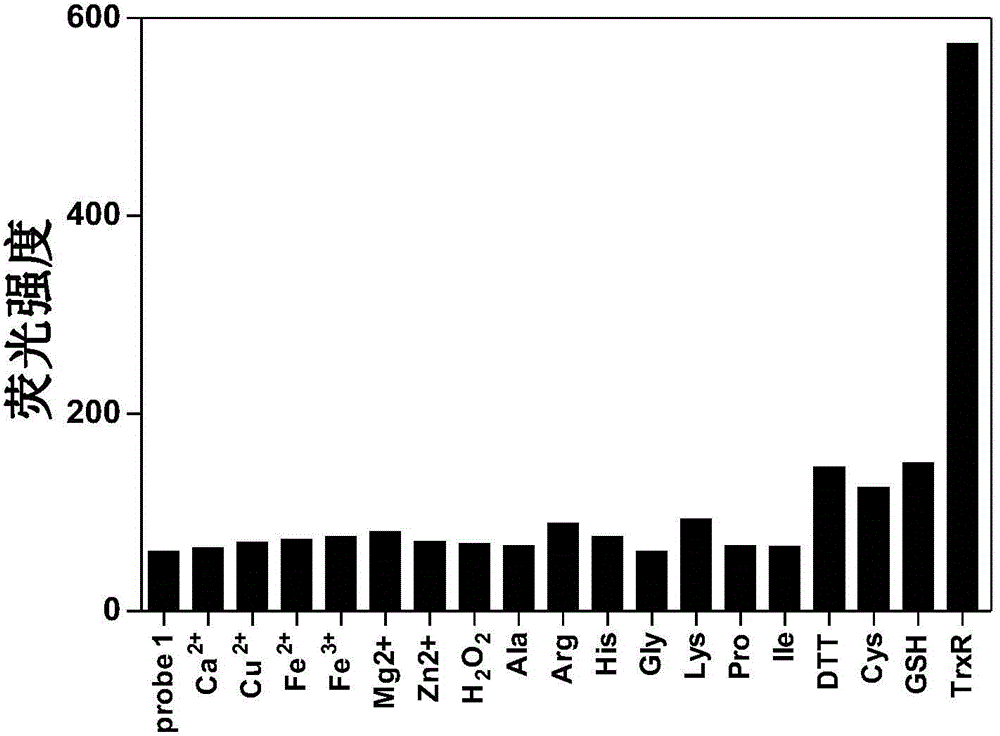Thioredoxin reductase fluorescent probe, and preparation method and application thereof
A technology of thioredoxin and fluorescent probes, applied in the field of fluorescent probes, to achieve the effects of simple synthetic route, rapid action and easy preparation
- Summary
- Abstract
- Description
- Claims
- Application Information
AI Technical Summary
Problems solved by technology
Method used
Image
Examples
preparation example Construction
[0028] The preparation method of the thioredoxin reductase fluorescent probe of the embodiment of the present invention is characterized in that it comprises the following steps:
[0029] Step 1: After dissolving 4-dihexylamino salicylaldehyde in a solvent, adding ethyl acetoacetate and piperidine, stirring and heating to reflux, cooling and filtering to obtain an intermediate compound;
[0030] Step 2: taking the intermediate compound, dissolving it in a solvent, adding 5-methylfuran aldehyde and piperidine, stirring and heating to reflux, cooling and separating by column chromatography to obtain the fluorescent probe for thioredoxin reductase.
[0031] Its preparation route is as follows:
[0032]
[0033] Specifically, the mass ratio of the 4-dihexylamino salicylaldehyde, ethyl acetoacetate and piperidine is 1:1.0~3.5:0.1~1.2; the intermediate compound, 5-methylfuran aldehyde, piperidine The mass ratio of pyridine is 1:0.4-1.6:0.2-1.6. The heating reflux temperature in...
Embodiment 1
[0042] Embodiment 1 Preparation of Fluorescent Probe for Thioredoxin Reductase
[0043]
[0044] Dissolve 1 g of 4-diethylamino salicylaldehyde (5.17 mmol) and 1.35 g of ethyl acetoacetate 4-diethylamino salicylaldehyde (10.38 mmol) in 20 ml of absolute ethanol, add 100 μl of piperidine as catalyst. The reaction solution was heated to reflux for 5 hours, cooled to room temperature, and a large number of yellow solids were precipitated. The yellow solid was suction filtered and washed with absolute ethanol to obtain the pure intermediate 1a (1.2 g, 4.6 mmol), with a yield of 90%. 1H NMR (400MHz, CDCl3) δ8.46(s, 1H), 7.40(d, J=9.0Hz, 1H), 6.63(dd, J=9.0, 2.3Hz, 1H), 6.48(d, J=2.2Hz , 1H), 3.47(q, J=7.1Hz, 1H), 2.69(s, 1H), 1.25(t, J=7.1Hz, 1H).
[0045] Intermediate 1a (250.0 mg, 0.96 mmol) and 5-methylfuran aldehyde (106.0 mg, 0.96 mmol) were dissolved in 20 ml of absolute ethanol, and 100 μl of piperidine was added as a catalyst. The reaction solution was heated to reflu...
Embodiment 2
[0046] Thioredoxin reductase inhibitory activity assay of embodiment 2 fluorescent probe
[0047] The DTNB method was used for the determination of fluorescent probe inhibition of thioredoxin reductase activity. All experiments were performed at 25°C. The total volume of the sample to be tested was 40 μl, which contained 0.3 μl of TrxR. The sample to be tested was added to 35.5 μl of buffer solution, which contained 1M phosphate (pH 7.0), 500 mM EDTA (pH 7.4), NADPH (0.48 mM) and 1 μl of fluorescent probes at different concentrations. After incubation for five minutes, 3.2 μl of DTNB was added to the reaction solution. The same volume of DMSO was added to the control group. Measure the increase process of the ultraviolet absorption intensity at 412nm within 120 seconds with a microplate reader, so as to calculate the inhibition of the thioredoxin reductase activity by the fluorescent probe. Measured IC 50 = 0.52 μM.
PUM
 Login to View More
Login to View More Abstract
Description
Claims
Application Information
 Login to View More
Login to View More - R&D
- Intellectual Property
- Life Sciences
- Materials
- Tech Scout
- Unparalleled Data Quality
- Higher Quality Content
- 60% Fewer Hallucinations
Browse by: Latest US Patents, China's latest patents, Technical Efficacy Thesaurus, Application Domain, Technology Topic, Popular Technical Reports.
© 2025 PatSnap. All rights reserved.Legal|Privacy policy|Modern Slavery Act Transparency Statement|Sitemap|About US| Contact US: help@patsnap.com



